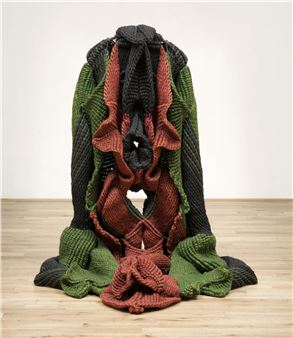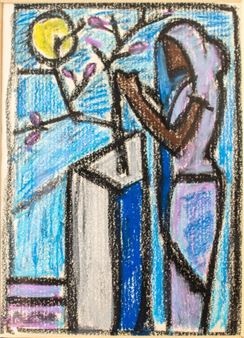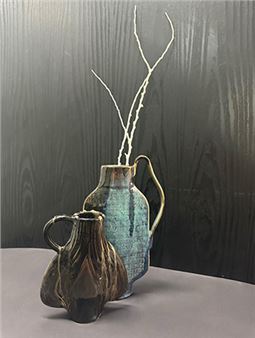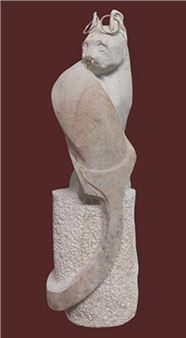Nandalal Bose: Mastermoshai
вҖңMastermoshaiвҖқ (as Nandalal Bose was affectionately called by his students) was perpetually drawing on cards and postcards. However, the pursuit of this activity was not just limited to him. Mastermoshai Nandalal Bose had instilled, both in his students as well as fellow professors, this practice of postcard drawing. Thus everyone, teachers and students alike, would remain engrossed in this vocation.
Most of Nandalal's cards are executed in monochrome - free from the bindings of colour. This approach set him apart from his Guru, Abanindranath Tagore. According to Abanindranth Tagore lines are the containers within which colours are held. He was of the view that it was primarily through colour that a painting could be brought to life. Nandalal, on the other hand, was extremely inquisitive about the many possibilities of lines. He found validation for his search in his encounter with Arai Kampo - leading him further towards his journey of monochromatic works.
It was his travels to East Asia that eventually paved the way for his huge body of work in brush and ink and strengthened his belief that black and white contain within them the potentialities of all the other colours. The printmaking techniques which became integral to the pedagogic practices of Kala Bhavana were also a result of Nandalal's travels to China and Japan. He had brought back with him various ukiyo-e prints and wood blocks.
While Indian classical art was highly encouraging of the use of a polychromatic colour scheme, the empowered use of monochrome brought with Nandalal the вҖҳAsian modeвҖҷ of understanding as a pedagogical practice to Santiniketan. Among the two schools of landscape painting - the Western traditions shaped by the likes of Constable and Turner and that of the Chinese Landscape tradition he was drawn towards the latterвҖҷs approach to nature and landscape painting. This further underscores his inclination towards an Asian belief system. When speaking of Nandalal's inspirations from Japan, his strong affirmation of the local and the current surroundings comes to light. This becomes an integral part of his cards.
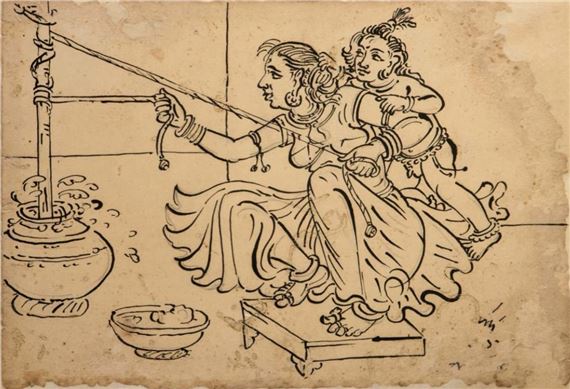
Recommended for you
вҖңMastermoshaiвҖқ (as Nandalal Bose was affectionately called by his students) was perpetually drawing on cards and postcards. However, the pursuit of this activity was not just limited to him. Mastermoshai Nandalal Bose had instilled, both in his students as well as fellow professors, this practice of postcard drawing. Thus everyone, teachers and students alike, would remain engrossed in this vocation.
Most of Nandalal's cards are executed in monochrome - free from the bindings of colour. This approach set him apart from his Guru, Abanindranath Tagore. According to Abanindranth Tagore lines are the containers within which colours are held. He was of the view that it was primarily through colour that a painting could be brought to life. Nandalal, on the other hand, was extremely inquisitive about the many possibilities of lines. He found validation for his search in his encounter with Arai Kampo - leading him further towards his journey of monochromatic works.
It was his travels to East Asia that eventually paved the way for his huge body of work in brush and ink and strengthened his belief that black and white contain within them the potentialities of all the other colours. The printmaking techniques which became integral to the pedagogic practices of Kala Bhavana were also a result of Nandalal's travels to China and Japan. He had brought back with him various ukiyo-e prints and wood blocks.
While Indian classical art was highly encouraging of the use of a polychromatic colour scheme, the empowered use of monochrome brought with Nandalal the вҖҳAsian modeвҖҷ of understanding as a pedagogical practice to Santiniketan. Among the two schools of landscape painting - the Western traditions shaped by the likes of Constable and Turner and that of the Chinese Landscape tradition he was drawn towards the latterвҖҷs approach to nature and landscape painting. This further underscores his inclination towards an Asian belief system. When speaking of Nandalal's inspirations from Japan, his strong affirmation of the local and the current surroundings comes to light. This becomes an integral part of his cards.

 ARTISTS
ARTISTS







